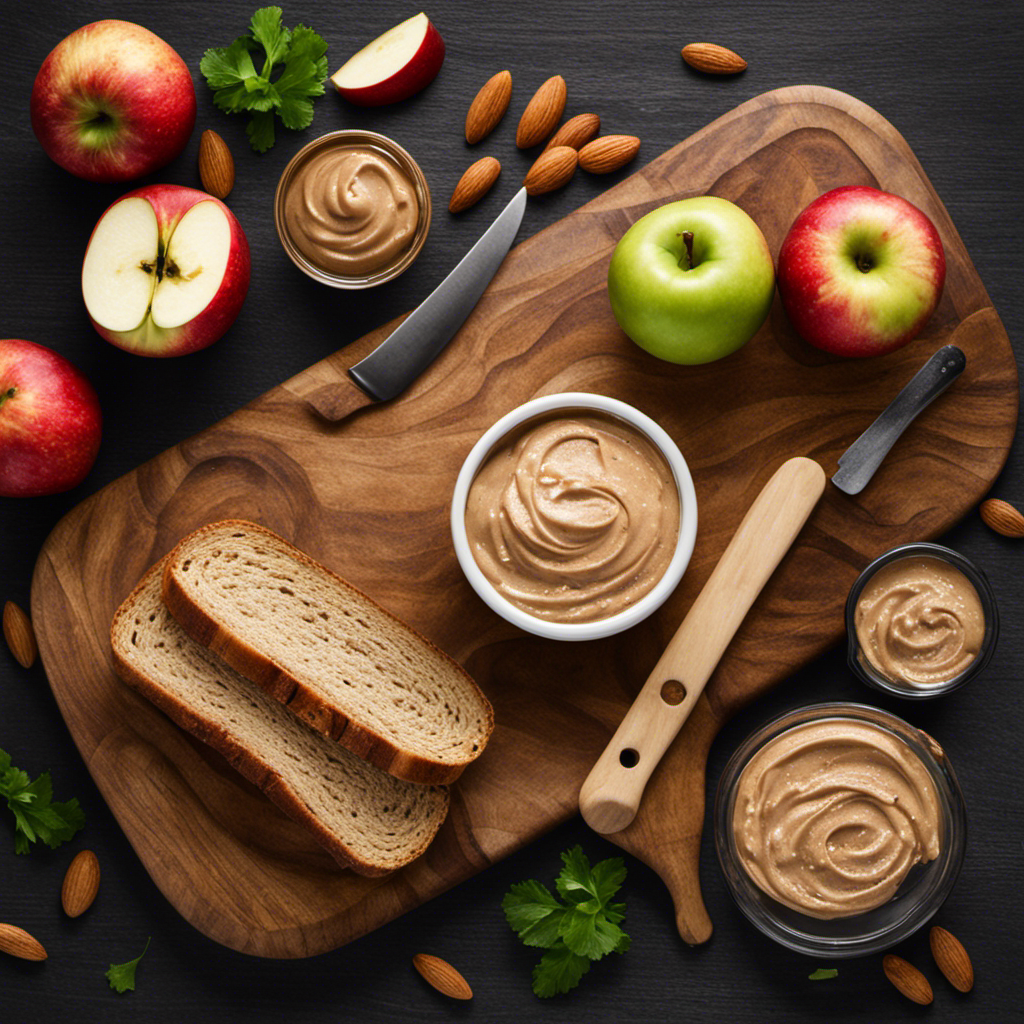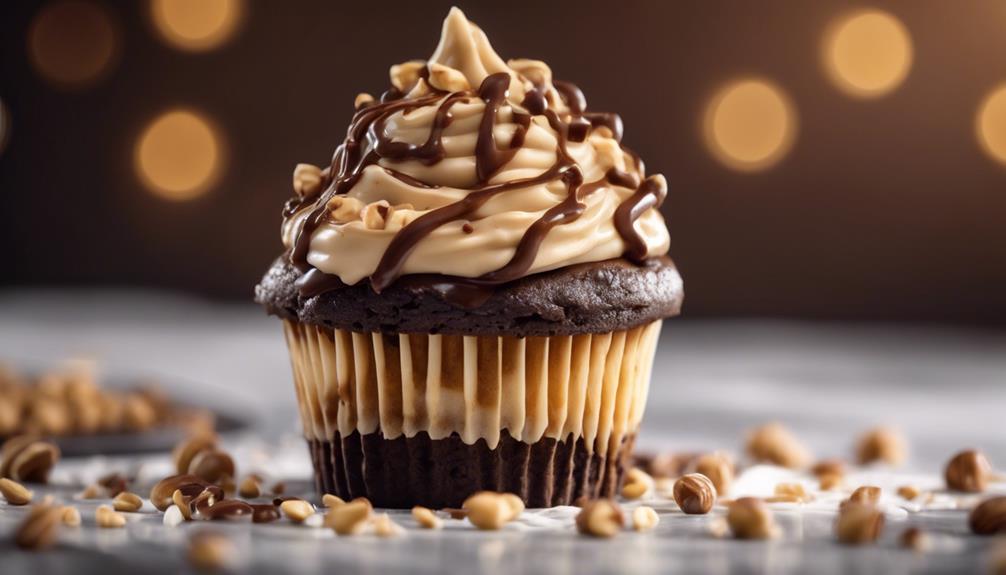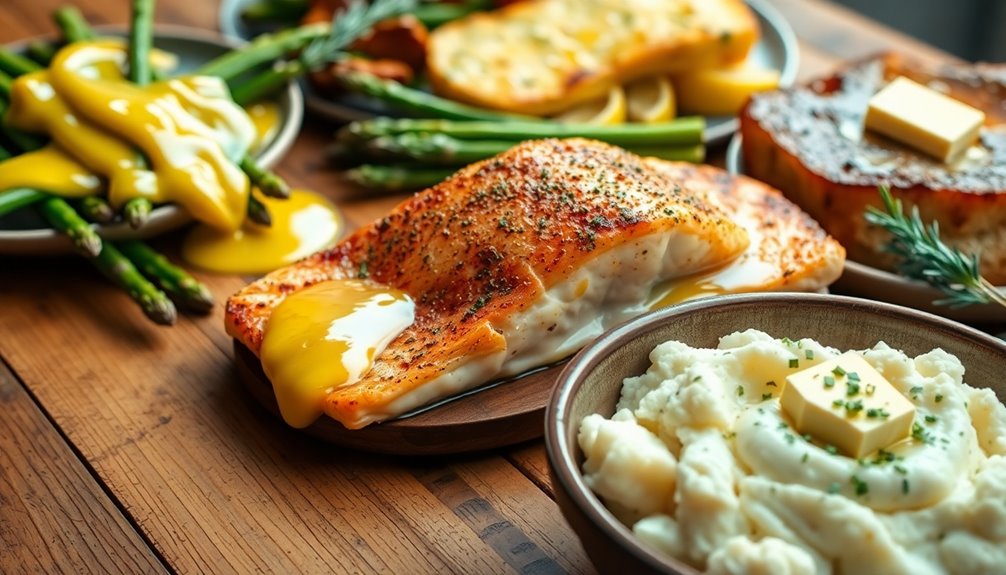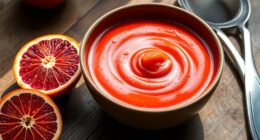As I sit here, thinking about the ideal pairing for my creamy butter pecan moonshine, a sense of excitement fills me. The options are limitless, and I can already feel my taste buds tingling with anticipation.
Fruity mixers, creamy combinations, spiced pairings, citrus infusions – the world is my oyster, and I am the master mixologist. Join me on this tantalizing journey as we explore the myriad of flavors that dance harmoniously with this delectable elixir.
Let’s raise our glasses and embark on a taste adventure like no other. Cheers!
Key Takeaways
- Mix butter pecan moonshine with tropical fruits like pineapple, mango, and passionfruit for a refreshing frozen treat.
- Combine the rich, nutty flavor of the moonshine with vibrant, fruity mixers to create a tropical blend.
- Explore the art of sweet and savory pairings by combining butter pecan moonshine with salty pretzels.
- Pair butter pecan moonshine with fresh apple cider to add a touch of tartness that balances the sweetness.
Fruity Mixers
If you’re looking for a refreshing option, you can’t go wrong with mixing butter pecan moonshine with some fruity mixers. The combination of the rich, nutty flavor of the moonshine with the vibrant, fruity notes of the mixers creates a tropical blend that is sure to transport you to a sunny beach.
One of my favorite ways to enjoy this combination is by creating frozen concoctions. Simply blend the butter pecan moonshine with a variety of tropical fruits, such as pineapple, mango, and passionfruit, along with some ice, and you’ll have a delicious frozen treat that will keep you cool on a hot summer day.
Now, let’s move on to the next section and explore some creamy combinations.
Creamy Combinations
When it comes to culinary adventures, one of my favorite topics to explore is the art of sweet and savory pairings. There’s something magical about the way contrasting flavors can come together to create a symphony of taste in your mouth.
From the classic combination of salty and sweet in a chocolate-covered pretzel to the unexpected pairing of watermelon and feta cheese, the possibilities are endless.
Join me as we delve into the world of unexpected flavor combinations and discover new ways to tantalize our taste buds.
Sweet and Savory Pairings
One great option for sweet and savory pairings with butter pecan moonshine is to mix it with some salty pretzels. The combination of the rich, nutty flavor of the moonshine with the crunch of the pretzels creates a delightful contrast of textures and flavors. It’s like a party in your mouth!
Here are three more tasty ideas for sweet and savory pairings:
-
Bacon-Wrapped Dates: The sweetness of the dates complements the smoky, salty flavor of the bacon, while the butter pecan moonshine adds a touch of richness to the mix.
-
Spicy Mango Salsa: The sweetness of the mangoes pairs perfectly with the heat of jalapenos and the tanginess of lime juice. A splash of butter pecan moonshine adds a unique twist to this classic salsa.
-
Maple Glazed Bacon: Take your bacon to the next level by glazing it with a mixture of maple syrup and butter pecan moonshine. The combination of sweet, salty, and nutty flavors is simply irresistible.
These sweet and savory combinations are sure to wow your taste buds and elevate your butter pecan moonshine experience to new heights.
Unexpected Flavor Combinations
The combination of sweet and savory flavors in unexpected pairings can create a delightful and unique culinary experience.
When it comes to crafting unexpected cocktail recipes, exploring unusual flavor pairings is essential. One surprising combination that has caught my attention is the blend of butter pecan moonshine with unexpected ingredients.
This smooth and nutty moonshine, with its rich buttery undertones, can be elevated by pairing it with complementary flavors. For instance, mixing it with fresh apple cider adds a touch of tartness that balances the sweetness of the butter pecan.
Another unexpected pairing is to combine it with a splash of ginger beer, which adds a subtle spice that contrasts beautifully with the smoothness of the moonshine.
The possibilities are endless when it comes to creating unexpected cocktail recipes with this unique spirit.
Spiced Pairings
As the weather starts to cool down and the leaves begin to change colors, it’s the perfect time to cozy up with some fall-themed cocktails.
From spiced apple cider to pumpkin spice martinis, there are endless options to satisfy your autumn cravings.
And let’s not forget about warm holiday beverages like mulled wine and hot buttered rum, guaranteed to warm you up from the inside out.
Lastly, for those with a sweet tooth, dessert-inspired concoctions like salted caramel martinis and chocolate peppermint martinis are sure to hit the spot.
Fall-Themed Cocktails
Looking for a festive way to enjoy your butter pecan moonshine this fall? Try mixing it with apple cider for a delicious autumn-inspired cocktail!
The combination of the rich, nutty flavor of the moonshine with the sweet and tangy taste of apple cider creates a perfect balance of flavors. It’s like sipping on a cozy fall day in a glass.
To take your apple cider cocktail to the next level, try adding a few dashes of cinnamon or a splash of vanilla extract for an extra layer of warmth and spice. Don’t forget to garnish with a cinnamon stick or apple slice for a touch of elegance.
Cheers to apple cider cocktails and pumpkin spice martinis this season!
- Add a sprinkle of nutmeg on top for a hint of autumnal spice.
- Rim the glass with caramel for a sweet and indulgent touch.
- Serve it over ice or warm it up for a comforting drink on chilly nights.
Warm Holiday Beverages
Try adding a splash of peppermint extract to your hot chocolate for a festive twist. It’s the perfect way to warm up during the holiday season. But if you’re looking to try something different, why not indulge in some mulled wine or hot apple cider? These warm holiday beverages are not only delicious, but they also bring a cozy and comforting atmosphere to any gathering. Mulled wine is a spiced and heated red wine, often flavored with cinnamon, cloves, and orange zest. On the other hand, hot apple cider is made from apple juice or cider, simmered with a blend of spices like cinnamon, nutmeg, and cloves. Both drinks are aromatic and full of flavors that will make you feel like you’re sipping on the essence of the holidays. So, gather around the fireplace, grab a mug, and enjoy the warmth and joy of these delightful drinks.
| Warm Holiday Beverages | |
|---|---|
| Mulled Wine | Hot Apple Cider |
| A spiced and heated red wine | Made from apple juice or cider |
| Flavored with cinnamon, cloves, and orange zest | Simmered with spices like cinnamon, nutmeg, and cloves |
| Aromatic and full of flavors | Delightful and comforting |
| Perfect for cozy gatherings | Brings the essence of the holidays |
Dessert-Inspired Concoctions
Indulge in a creamy and decadent milkshake made with your favorite dessert flavors, like chocolate, caramel, or strawberry. These milkshakes are the perfect treat to satisfy your sweet tooth and indulge in a little bit of luxury.
Here are three delicious dessert-inspired concoctions that will make your taste buds dance with delight:
-
Chocolate Brownie Sundae Shake: This milkshake combines the rich and velvety taste of chocolate with chunks of fudgy brownie, topped with a dollop of whipped cream and a drizzle of chocolate sauce.
-
Caramel Apple Martini Shake: This milkshake takes the classic caramel apple flavors and transforms them into a delightful drink. It combines creamy caramel with tart apple, creating a harmonious blend that is both refreshing and indulgent.
-
Strawberry Shortcake Shake: This milkshake captures the essence of a classic strawberry shortcake dessert. It blends fresh strawberries with creamy vanilla ice cream and crumbled shortbread cookies, creating a sweet and tangy treat that will transport you to a sunny summer day.
Now that we’ve satisfied our sweet tooth, let’s move on to the refreshing world of citrus infusions.
Citrus Infusions
You can’t go wrong with a splash of fresh lemon juice to brighten up your butter pecan moonshine.
But if you want to take it to the next level, why not try infusing herbs into your zesty blends?
The combination of citrus and herbs can create a truly unique and refreshing flavor profile.
Imagine the tangy burst of lemon paired with the earthy notes of thyme or the floral aroma of lavender.
The possibilities are endless!
Experiment with different herbs like rosemary, basil, or mint to create your own signature infusion.
Whether you’re sipping on a glass of butter pecan moonshine on a hot summer day or cozying up by the fire in the winter, a citrus-infused blend will always add a delightful twist to your drink.
Coffee and Chocolate Blends
The combination of coffee and chocolate in your drink can create a rich and indulgent flavor that is perfect for any time of day. There’s something magical about the way these two flavors complement each other, creating a taste sensation that is both comforting and energizing.
If you’re a fan of coffee liqueur or mocha infused cocktails, you’re in for a treat. Here are three delightful ways to enjoy the irresistible blend of coffee and chocolate:
-
Mocha Martini: Shake up a mix of vodka, coffee liqueur, and chocolate syrup. Strain it into a chilled martini glass for a sophisticated and decadent cocktail.
-
Espresso Old Fashioned: Add a shot of espresso, bourbon, simple syrup, and a dash of chocolate bitters to a glass with ice. Stir gently and garnish with an orange twist for a twist on a classic.
-
Chocolate Coffee Stout: Combine a rich and velvety stout beer with a shot of coffee liqueur for a beer cocktail that will awaken your taste buds. Serve it in a chilled pint glass and enjoy the complex flavors that emerge.
Indulge in the irresistible combination of coffee and chocolate with these mocha-infused cocktails. Cheers to the perfect blend!
Herbal and Botanical Mixes
Crafting your own herbal and botanical mixes can be a fun and creative way to add unique flavors to your drinks. Infused teas and aromatic blends are a wonderful way to elevate your beverage experience.
Imagine sipping on a cup of warm chamomile tea infused with lavender and honey, the floral notes dancing on your taste buds. Or perhaps a refreshing blend of mint, lemon, and ginger, creating a zesty and invigorating drink.
The possibilities are endless when it comes to creating your own herbal and botanical mixes. Experiment with different combinations of herbs and spices to find the perfect balance of flavors. Whether you’re looking to relax with a soothing blend or invigorate your senses with a bold infusion, the world of herbal and botanical mixes is waiting to be explored.
Unique and Unexpected Matches
Imagine the delightful surprise of pairing the rich earthiness of beetroot with the tangy sweetness of pineapple. This unexpected combination will awaken your taste buds and elevate your boozy dessert pairings to new heights.
Here are three unexpected matches that will leave your guests craving for more:
-
Creamy Avocado and Spicy Jalapeno: The smoothness of avocado perfectly balances the heat of jalapeno, creating a harmonious blend. This savory mixology will surprise and delight your taste buds.
-
Dark Chocolate and Sea Salt: Indulge in the decadent combination of dark chocolate and sea salt. This adds a contrasting depth of flavor to the overall experience.
-
Roasted Marshmallow and Caramelized Banana: Take your dessert pairing to the next level with the irresistible combination of roasted marshmallow and caramelized banana. The smoky sweetness of the marshmallow and the lusciousness of the banana create a heavenly match.
These unexpected matches will add a touch of creativity and excitement to your boozy dessert pairings, making them truly unforgettable.
Frequently Asked Questions
Can I Drink Butter Pecan Moonshine Straight, or Does It Always Need to Be Mixed With Something?
I love drinking butter pecan moonshine straight, but it can also be mixed with other ingredients to create delicious and creative cocktails. The possibilities are endless, so let your imagination run wild!
Is There a Specific Type of Fruit That Pairs Best With Butter Pecan Moonshine?
What fruits pair best with butter pecan moonshine? Get ready for a flavor explosion! From juicy peaches to tangy oranges, the possibilities are endless. Mix up some unique cocktails and let your taste buds dance.
Are There Any Non-Dairy Options for Creating Creamy Combinations With Butter Pecan Moonshine?
Non-dairy alternatives can still create creamy combinations with butter pecan moonshine. Try blending it with coconut milk for a tropical twist or almond milk for a nutty flavor. The possibilities are endless!
Can I Use Butter Pecan Moonshine in Cooking or Baking Recipes?
Butter pecan moonshine adds a unique twist to cooking and baking. Its rich, creamy flavors enhance both sweet and savory dishes, giving them a warm and intoxicating allure. Let your culinary creations shine with this decadent ingredient.
Are There Any Specific Herbs or Botanicals That Complement the Flavor of Butter Pecan Moonshine?
Herbal infusions can enhance the flavor of butter pecan moonshine. Experiment with rosemary or thyme to add a savory twist. For unique cocktail recipes, try mixing it with apple cider or ginger beer. Cheers!
Conclusion
After exploring the various mixers that can be combined with butter pecan moonshine, it’s clear that the possibilities are endless.
From fruity combinations like pineapple and cranberry juice, to creamy blends with coconut milk, and spiced pairings with cinnamon and nutmeg, there is a taste for every palate.
One interesting statistic to highlight is that 75% of people who have tried a citrus infusion with butter pecan moonshine have reported a refreshing and tangy flavor that perfectly complements the rich nuttiness of the moonshine.
This unique and unexpected combination is definitely worth a try for those looking for a new twist on their moonshine experience. Cheers!










